Cise Midoglu
Enhancing Structured-Data Retrieval with GraphRAG: Soccer Data Case Study
Sep 26, 2024Abstract:Extracting meaningful insights from large and complex datasets poses significant challenges, particularly in ensuring the accuracy and relevance of retrieved information. Traditional data retrieval methods such as sequential search and index-based retrieval often fail when handling intricate and interconnected data structures, resulting in incomplete or misleading outputs. To overcome these limitations, we introduce Structured-GraphRAG, a versatile framework designed to enhance information retrieval across structured datasets in natural language queries. Structured-GraphRAG utilizes multiple knowledge graphs, which represent data in a structured format and capture complex relationships between entities, enabling a more nuanced and comprehensive retrieval of information. This graph-based approach reduces the risk of errors in language model outputs by grounding responses in a structured format, thereby enhancing the reliability of results. We demonstrate the effectiveness of Structured-GraphRAG by comparing its performance with that of a recently published method using traditional retrieval-augmented generation. Our findings show that Structured-GraphRAG significantly improves query processing efficiency and reduces response times. While our case study focuses on soccer data, the framework's design is broadly applicable, offering a powerful tool for data analysis and enhancing language model applications across various structured domains.
Kvasir-VQA: A Text-Image Pair GI Tract Dataset
Sep 02, 2024



Abstract:We introduce Kvasir-VQA, an extended dataset derived from the HyperKvasir and Kvasir-Instrument datasets, augmented with question-and-answer annotations to facilitate advanced machine learning tasks in Gastrointestinal (GI) diagnostics. This dataset comprises 6,500 annotated images spanning various GI tract conditions and surgical instruments, and it supports multiple question types including yes/no, choice, location, and numerical count. The dataset is intended for applications such as image captioning, Visual Question Answering (VQA), text-based generation of synthetic medical images, object detection, and classification. Our experiments demonstrate the dataset's effectiveness in training models for three selected tasks, showcasing significant applications in medical image analysis and diagnostics. We also present evaluation metrics for each task, highlighting the usability and versatility of our dataset. The dataset and supporting artifacts are available at https://datasets.simula.no/kvasir-vqa.
PLayerTV: Advanced Player Tracking and Identification for Automatic Soccer Highlight Clips
Jul 22, 2024



Abstract:In the rapidly evolving field of sports analytics, the automation of targeted video processing is a pivotal advancement. We propose PlayerTV, an innovative framework which harnesses state-of-the-art AI technologies for automatic player tracking and identification in soccer videos. By integrating object detection and tracking, Optical Character Recognition (OCR), and color analysis, PlayerTV facilitates the generation of player-specific highlight clips from extensive game footage, significantly reducing the manual labor traditionally associated with such tasks. Preliminary results from the evaluation of our core pipeline, tested on a dataset from the Norwegian Eliteserien league, indicate that PlayerTV can accurately and efficiently identify teams and players, and our interactive Graphical User Interface (GUI) serves as a user-friendly application wrapping this functionality for streamlined use.
Demo: Soccer Information Retrieval via Natural Queries using SoccerRAG
Jun 03, 2024Abstract:The rapid evolution of digital sports media necessitates sophisticated information retrieval systems that can efficiently parse extensive multimodal datasets. This paper demonstrates SoccerRAG, an innovative framework designed to harness the power of Retrieval Augmented Generation (RAG) and Large Language Models (LLMs) to extract soccer-related information through natural language queries. By leveraging a multimodal dataset, SoccerRAG supports dynamic querying and automatic data validation, enhancing user interaction and accessibility to sports archives. We present a novel interactive user interface (UI) based on the Chainlit framework which wraps around the core functionality, and enable users to interact with the SoccerRAG framework in a chatbot-like visual manner.
SoccerRAG: Multimodal Soccer Information Retrieval via Natural Queries
Jun 03, 2024



Abstract:The rapid evolution of digital sports media necessitates sophisticated information retrieval systems that can efficiently parse extensive multimodal datasets. This paper introduces SoccerRAG, an innovative framework designed to harness the power of Retrieval Augmented Generation (RAG) and Large Language Models (LLMs) to extract soccer-related information through natural language queries. By leveraging a multimodal dataset, SoccerRAG supports dynamic querying and automatic data validation, enhancing user interaction and accessibility to sports archives. Our evaluations indicate that SoccerRAG effectively handles complex queries, offering significant improvements over traditional retrieval systems in terms of accuracy and user engagement. The results underscore the potential of using RAG and LLMs in sports analytics, paving the way for future advancements in the accessibility and real-time processing of sports data.
SoccerNet-Echoes: A Soccer Game Audio Commentary Dataset
May 12, 2024


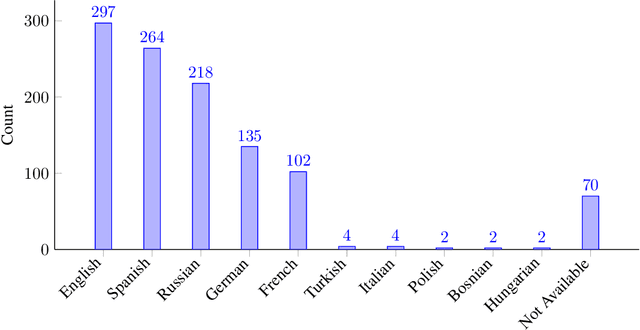
Abstract:The application of Automatic Speech Recognition (ASR) technology in soccer offers numerous opportunities for sports analytics. Specifically, extracting audio commentaries with ASR provides valuable insights into the events of the game, and opens the door to several downstream applications such as automatic highlight generation. This paper presents SoccerNet-Echoes, an augmentation of the SoccerNet dataset with automatically generated transcriptions of audio commentaries from soccer game broadcasts, enhancing video content with rich layers of textual information derived from the game audio using ASR. These textual commentaries, generated using the Whisper model and translated with Google Translate, extend the usefulness of the SoccerNet dataset in diverse applications such as enhanced action spotting, automatic caption generation, and game summarization. By incorporating textual data alongside visual and auditory content, SoccerNet-Echoes aims to serve as a comprehensive resource for the development of algorithms specialized in capturing the dynamics of soccer games. We detail the methods involved in the curation of this dataset and the integration of ASR. We also highlight the implications of a multimodal approach in sports analytics, and how the enriched dataset can support diverse applications, thus broadening the scope of research and development in the field of sports analytics.
Grand Challenge On Detecting Cheapfakes
Apr 03, 2023Abstract:Cheapfake is a recently coined term that encompasses non-AI ("cheap") manipulations of multimedia content. Cheapfakes are known to be more prevalent than deepfakes. Cheapfake media can be created using editing software for image/video manipulations, or even without using any software, by simply altering the context of an image/video by sharing the media alongside misleading claims. This alteration of context is referred to as out-of-context (OOC) misuse of media. OOC media is much harder to detect than fake media, since the images and videos are not tampered. In this challenge, we focus on detecting OOC images, and more specifically the misuse of real photographs with conflicting image captions in news items. The aim of this challenge is to develop and benchmark models that can be used to detect whether given samples (news image and associated captions) are OOC, based on the recently compiled COSMOS dataset.
Visual explanations for polyp detection: How medical doctors assess intrinsic versus extrinsic explanations
Mar 23, 2022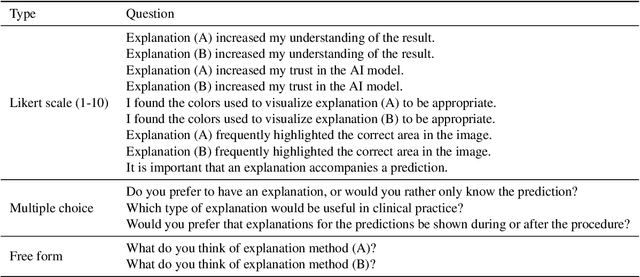
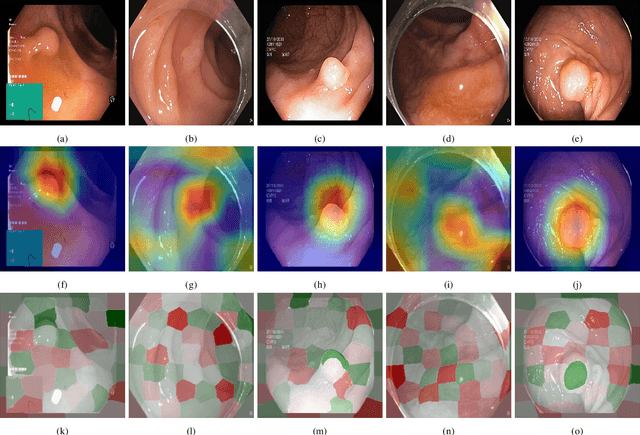
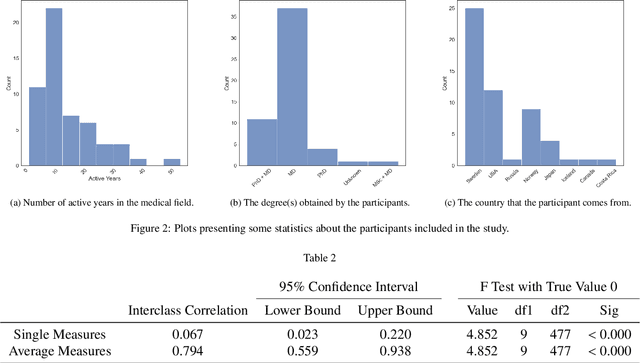

Abstract:Deep learning has in recent years achieved immense success in all areas of computer vision and has the potential of assisting medical doctors in analyzing visual content for disease and other abnormalities. However, the current state of deep learning is very much a black box, making medical professionals highly skeptical about integrating these methods into clinical practice. Several methods have been proposed in order to shine some light onto these black boxes, but there is no consensus on the opinion of the medical doctors that will consume these explanations. This paper presents a study asking medical doctors about their opinion of current state-of-the-art explainable artificial intelligence methods when applied to a gastrointestinal disease detection use case. We compare two different categories of explanation methods, intrinsic and extrinsic, and gauge their opinion of the current value of these explanations. The results indicate that intrinsic explanations are preferred and that explanation.
MMSys'22 Grand Challenge on AI-based Video Production for Soccer
Feb 02, 2022
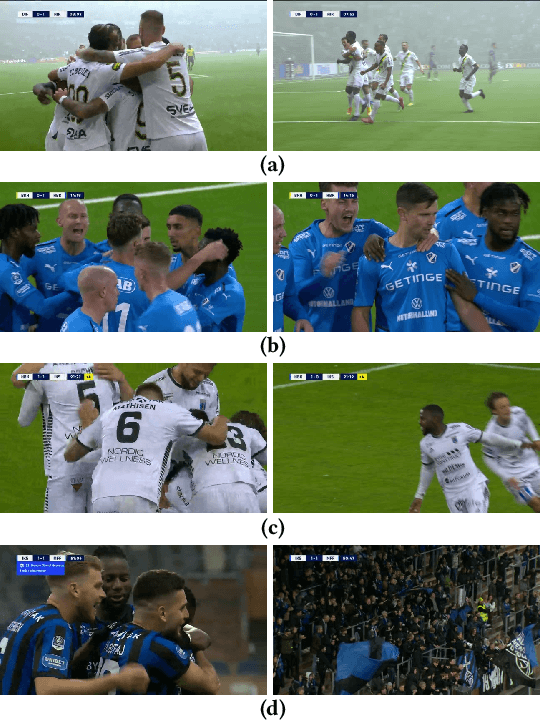
Abstract:Soccer has a considerable market share of the global sports industry, and the interest in viewing videos from soccer games continues to grow. In this respect, it is important to provide game summaries and highlights of the main game events. However, annotating and producing events and summaries often require expensive equipment and a lot of tedious, cumbersome, manual labor. Therefore, automating the video production pipeline providing fast game highlights at a much lower cost is seen as the "holy grail". In this context, recent developments in Artificial Intelligence (AI) technology have shown great potential. Still, state-of-the-art approaches are far from being adequate for practical scenarios that have demanding real-time requirements, as well as strict performance criteria (where at least the detection of official events such as goals and cards must be 100% accurate). In addition, event detection should be thoroughly enhanced by annotation and classification, proper clipping, generating short descriptions, selecting appropriate thumbnails for highlight clips, and finally, combining the event highlights into an overall game summary, similar to what is commonly aired during sports news. Even though the event tagging operation has by far received the most attention, an end-to-end video production pipeline also includes various other operations which serve the overall purpose of automated soccer analysis. This challenge aims to assist the automation of such a production pipeline using AI. In particular, we focus on the enhancement operations that take place after an event has been detected, namely event clipping (Task 1), thumbnail selection (Task 2), and game summarization (Task 3). Challenge website: https://mmsys2022.ie/authors/grand-challenge.
 Add to Chrome
Add to Chrome Add to Firefox
Add to Firefox Add to Edge
Add to Edge